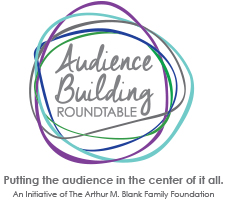Sara Leonard, Founder and Principal, Sara Leonard Consulting
When the Arthur M. Blank Family Foundation convened a workshop on November 2, 2015 to talk about audience development, I was struck by the tagline they chose: “Building Your Organization for Audiences.”
Building the organization for its audience. The phrase seems just right, and yet I don’t think I’ve ever heard it said that way before. We talk so often about how to build audiences for our arts organizations, but that seems to separate the organization from the audience somehow. The audience becomes a group of people who serve our organizations by bringing us revenue, rather than being necessary partners in the creation of works of art that aren’t truly complete until they are viewed. But if we build our organizations for audiences, we are inviting them in. There is a warmth to that idea, a sense that our organizations are made complete when our audiences join us. Touchy-feely? Maybe. But it’s also part of the mandate for nonprofit arts organizations that make a commitment to serve their communities, however they may be defined.
When we see building audience as the whole organization’s job, then the whole organization is fair game for examination if audiences are withering.
The question then becomes, how do we do it? How do we invite audiences in and develop relationships with them that entice them to stay with us and become our partners? The answer lies in a process of relationship building in which engaging and serving the audience is at the organization’s core. Here’s a place to start:
- Make audience development an organization-wide priority. There is a tendency to make the task of developing audiences the sole purview of the marketing department, but in order to build loyal and lasting audiences, the whole organization needs to get involved. That means that the audience should be considered as all decisions – artistic or otherwise – are made, and that staff tasked with marketing and audience development should be at the table. Of course, when we see building audience as the whole organization’s job, then the whole organization is fair game for examination if audiences are withering. Does the mission still connect with the community? Is the organization lacking sufficient focus? In order to make meaningful connections with audiences, organizations will need to…
- Know both current and would-be audiences. The key here is to dive beyond the surface. Demographics can be a starting point for broadening or diversifying audiences, but they don’t actually offer a whole lot on which to build a relationship. People build their sense of self from any number of factors, both chosen and innate. Find out what makes your current and desired audiences tick, what they are interested in, and what they value. Then find the places where organizational interests and priorities authentically intersect with theirs. Give people a personality to connect with. The result will be an audience that fits with the organization; the flipside is that the organization’s personality will not be a fit for everyone. That can be scary, but a strong identity allows for deeper relationships with the audience that will actually sustain the organization. So, how do you get to know these folks in order to find the connection points? Talk to them at performances or exhibitions, get involved with other community organizations, and go to the places they like to go. Of course, in order to build these connections, you’ll also need to…
- Know the organization. This brings us full circle. Marketing and audience development can’t exist in a vacuum. Organizations must cultivate an identity that is clearly and consistently expressed through the art it produces or presents, the language and images it uses, and its internal and external culture. This is the organization’s personality. It is grounded in mission, but extends beyond it. It is how a would-be audience member knows whether an organization feels like home, like a place that their needs and desires are met, and like a place where they want to spend their valued time and resources.
People make time for and spend money on the things that they value. So, the task is to find the places where the organization’s interests, values and priorities connect meaningfully and authentically to those of our prospective audience members. Then, communicate. Clearly. Consistently.
In When Going Gets Tough: Barriers and Motivations Affecting Arts Attendance, my co-authors and I reveal that “lack of time” is the most commonly cited barrier to arts attendance. However, deeper analysis suggests that the real problem is not individuals literally lacking available hours in the day. Rather, it seems to be that a sufficiently compelling case has not yet been made to convince would-be attendees to spend some of their limited time at our organizations. People make time for and spend money on the things that they value. So, the task is to find the places where the organization’s interests, values, and priorities connect meaningfully and authentically to those of our prospective audience members. Then, communicate. Clearly. Consistently.
It’s intentional relationship building that will bring our organizations the audiences who will find a home with us and make us a part of their lives.
The silver bullet we all wish for does not, unfortunately, exist. It’s a pity, really, since the daily realities of running an arts organization make it difficult to take the time and mental space to step back and take a long view of audience development. But, it’s this intentional relationship building that will bring our organizations the audiences who will find a home with us and make us a part of their lives. These are the loyal audiences that will sustain our organizations into the future.
Keywords: Audience building, organizational identity, authenticity
